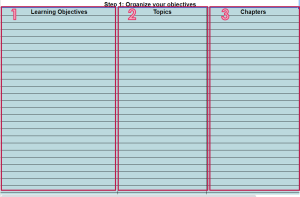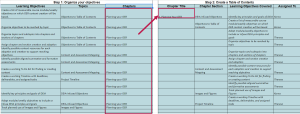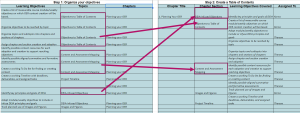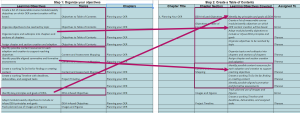Designing Your Garden: Mapping & Planning Your OER
Writing Measurable, Student-Centered Objectives
Ensure your objectives are measurable
Now that you have ensured the foundation of your OER incorporates DEIA principles and goals, they must be reviewed to ensure they are measurable.
- We cannot create OER content without a clear picture of what our students will need to do with that content. By creating measurable objectives before we write or adapt, the scope of the writing is clarified.
- We cannot assess what we cannot measure. By creating measurable objectives, choices for formative and summative assessments are clarified.
View this interactive video to learn how to ensure your objectives are measurable:
Measurable Objectives
What's This Tool? - H5P Interactive Video
Figure 1.6. Instructional Technologist, Fan Yang, walks through several unmeasurable objectives and offers several ways to reframe them and ensure they are measurable.
Your Turn: Step 3 – Revise objectives to be measurable and student-centered.
In the OER Objectives Worksheet tab of your OERFSJ Deliverables 1-5 spreadsheet in your team’s Google folder, take another look your DEIA-infused list of Original Weekly or Module Objectives . Review them to make sure they are:
- Measurable.
- Your module or weekly objectives should begin with an action verb that can be measured (“Research”, “Use”, “Analyze”).
- Examples of objectives that cannot be measured usually start with verbs like “understand”, “know”, “appreciate”, “familiarize”, “study”, “be aware”, “become acquainted with”, “gain knowledge of”, “realize”, or “learn”.
Example of revising objectives to make it measurable:
-
-
- Replace: Understand persuasive strategies to structure verbal messages that are adapted to specific audiences.
- With: Identify the five persuasive strategies.
- And/or: Adapt verbal messages to persuade specific audiences.
-
Note: Understanding cannot be measured. Reframe from the student’s perspective. What do want the student to do to show they understand?
-
-
- In the Measurable Weekly or Module Objectives column , replace these vague, unmeasurable verbs with verbs that state exactly what the student will do.
-
- Written from the student’s perspective.
- Your module or weekly objectives should complete a sentence that begins with “By the end of this module/week, students will be able to…”
- Example of revising objectives to the student’s perspective:
- Replace: Increase awareness of social justice issues in the current public education system
-
-
- With: Identify a variety of social justice issues in the current public education system.
-
Note: While this objective states what the instructor or content intends to do, without framing it from the student’s perspective, it is not clear what the student will need to do to demonstrate they have increased their awareness.
Beware Nested Objectives
Nested Objectives can complicate the designing of your OER. Ensuring you “unnest” your objectives before you try to map your content and assessments can save you loads of time and frustration down the road and help your students understand expectations.
Take a few minutes to look through the slides below. You’ll find out what exactly “nested objectives” are, why they are troublesome, and how to easily fix them.
What's this Tool? - H5P Course Presentation
A final review of your objectives
Review your list of DEIA-infused, measurable objectives in the Measurable Weekly and Module Objectives column. Particularly in a project in which your OER will be used in several different courses, there may be some objectives that are duplicated or some that could be combined into one. You may have also added some weekly or module objectives that may not align with your course outcomes. In this last step, you will shore up those pieces and complete your objective list.
Your Turn: Step 4 – Finalize your objectives.
You should have all your DEIA-infused, measurable objectives now listed in the Measurable Weekly and Module Objectives column of the OER Objectives Worksheet. Review them once more using the following prompts:
- Which objectives repeat and could be combined?
- Remove repeated objectives and combine those that make sense together.
- Do all your objectives align with the course objectives?
- Look back at Course Outcomes you listed at the left of your OER Objectives Worksheet.
- Make sure that all your module/weekly objectives align with and support at least one of those Course Outcomes. This ensures what you are teaching and the OER you are adapting or creating stays within the scope of the course.
Once you have narrowed down your list to include the essential objectives, your OER Objectives Worksheet is complete.
Next, you will use these objectives you just revised to begin organizing the framework of your OER into topics, chapters, and finally a Table of Contents.
Deliverable 1
Deliverable 1 is the OER Objectives Worksheet.
Once complete, you are ready to upload your OERFSJ Deliverables 1-5 spreadsheet to your team’s OERFSJ Google folder, and email OERFSJ@lmu.edu to let them know your Deliverable 1 is complete.
Resources
Instructional Technology at Mount St. Joseph. (2020, May 4). Measurable Objectives. [Video]. Measurable Objectives (youtube.com)
Additional Reading (and Listening):
Licenses and Attributions
“Measurable and Student-Centered Objectives” by Theresa Huff is licensed under CC BY 4.0.
Because objectives are the foundation or backbone of the OER, we will use those objectives to map out and organize all other parts of the OER, including the Table of Contents. If the objectives are the backbone, the Table of Contents can be thought of as the skeleton of the OER that is supported by the objectives. In this section, you will organize your objectives into topics and then into chapters. Follow the steps and guidance provided in the Your Turn boxes and the 2. Directions – OER Objectives Organizer in this section. By the end of this section, you will have a workable Table of Contents for your OER with chapter and subsections, which can then be assigned to individual team members for creation or adaption.
Organizing Objectives into Topics and Chapters
It can be overwhelming to begin creating or adapting an OER. You might be asking:
Where do I start?
What content should I cover?
In what order do I put chapters and sections?
Working through the OER Objective Organizer tab of the OERFSJ Deliverables 1-5 spreadsheet as a team will help you find answers to all of these questions.
To see an example of a completed OER Objective Organizer, take a look at the Completed OERFSJ Deliverables 1-5.
Your Turn: Step 1 – Complete the OER Objective Organizer
Using your team’s OERFSJ Deliverables 1-5 spreadsheet in your team’s OERFSJ Google folder, find the OER Objective Organizer tab. You will notice that the Learning Objectives are automatically populated from your OER Objectives Worksheet’s Measurable Weekly and Module Objectives column [1].

Follow the directions on the 2. Directions – OER Objectives Organizer to
- Organize the objectives by topic. Review the Learning Objectives. Ask yourself the following question:
“What topics need to be covered in the OER for students to be able to achieve this objective?”
-
- Type these topics into Topics column [2] next to each learning objectives. As you go through the objectives, adding topics, you may see that several objectives fall under the same or similar topics.
- These Topics will likely become your chapter’s sections in your OER.
-
- Group into Chapters. Now that you have your learning objectives grouped by topic, decide which topics can be grouped into each chapter.
-
-
- Look through the list of topics in the Topics column. Which topics would work well together in a chapter?
- In the Chapters column [3], give each topic the name of a chapter under which that topic falls. There will likely be several topics that fall under the same chapter. Don’t worry about choosing the perfect chapter name just yet. You can keep thinking and perfecting chapter names as you create the OER.
-
Choosing Topics and Chapters
Feeling uncertain about this task? Practice finding topics for objectives and chapter for topics in this low-stakes activity below.
Creating a Table of Contents
Now that you have assigned your objectives to a topic and your topics to a chapter, you can organize these items into a Table of Contents. When creating the Table of Contents, you will want to answer the following question:
In what order do I want to guide my students through the content?
The Table of Contents (located under Step 2: Create a Table of Contents on the OER Objectives Organizer tab is “workable”. This means it is not set in stone, because, as you create or adapt content, you may find a chapter’s sections need to be rearranged in a different order to suite the flow of your OER. Do the best you can with what you know now to create this skeleton.
Your Turn: Step 2 – Create a Table of Contents
1.Start by deciding the order in which your chapters from the Chapters column will be arranged in your OER. These become and are placed in your Chapter Titles column in the OER Objective Organizer.

2.Next, place your Topics into the Chapter Section aligned with the chapter under which they fall.

3.Finally, place the Learning Objectives into Learning Objectives Covered, aligned with the topics under which they fall.

Assign Content
You may not be ready to start writing or adapting or even thinking about writing right now. That is just fine. However, assigning the content now is essential to give team members the flexibility to start when they are ready. Deadlines for writing content will be set down the road. For now, as a team, you will divvy up the chapters or sections to individual members who will be responsible at some time for their completion.
Your Turn: Step 3 – Assign Content
Once you have your Table of Contents completed, you are ready to take ownership for the creation or adaption of individual sections or chapter. As a team, decide who will author and/or adapt each section.
Type the name of the individual team member who will take responsibility for authoring or adapting each chapter or section in the Assigned To column of your OER Objectives Organizer.

Once your Table of Contents is complete and each chapter or section is assigned, your OER Objective Organizer is complete.
Next, you will be looking at your assigned sections and making a plan for adapting or creating its content, pulling pieces of OER you identified from your Year 1 Gap Analysis, and making an individual To Do List to prepare you for authoring or adapting your OER.
Deliverable 2
Deliverable 2 is the completed OER Objective Organizer, which contains the Objective Organizer, Table of Contents, and assigned portions.
Once complete, you are ready to upload your OERFSJ Deliverables 1-5 spreadsheet to your team’s OERFSJ Google folder, and email OERFSJ@lmu.edu to let them know your Deliverable 2 is complete.
Licenses and Attributions
“Organizing Objectives” by Theresa Huff is licensed under CC BY 4.0.
This is a H5P Interactive Video. This H5P type allows creators to add engaging interactivity and formative assessments to existing videos.
H5P is a free, open-source interactivity building tool built into Pressbooks. The H5P Interactive Video is one of over 50 different types of H5P interactives.
This is an H5P Course Presentation Tool. This H5P type allows creators to use presentation slides with embedded elements such as links, pictures, audio and video clips, and interactive quiz tools.
H5P is a free, open-source interactivity building tool built into Pressbooks. The H5P Course Presentation is one of over 50 different types of H5P interactives.
This is an H5P Quiz. This H5P type allows creators to add a set of different types of quiz questions such as multiple choice, drag and drop, or fill in the blank questions.
H5P is a free, open-source interactivity building tool built into Pressbooks. The H5P Quiz is one of over 50 different types of H5P interactives.
